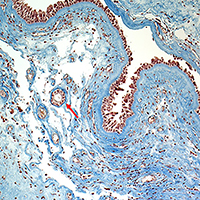Can the AGE/RAGE/ERK signalling pathway and the epithelial-to-mesenchymal transition interact in the pathogenesis of chronic rhinosinusitis with nasal polyps?

Submitted: 21 October 2019
Accepted: 14 January 2020
Published: 23 January 2020
Accepted: 14 January 2020
Abstract Views: 1550
PDF: 911
HTML: 7
HTML: 7
Publisher's note
All claims expressed in this article are solely those of the authors and do not necessarily represent those of their affiliated organizations, or those of the publisher, the editors and the reviewers. Any product that may be evaluated in this article or claim that may be made by its manufacturer is not guaranteed or endorsed by the publisher.
All claims expressed in this article are solely those of the authors and do not necessarily represent those of their affiliated organizations, or those of the publisher, the editors and the reviewers. Any product that may be evaluated in this article or claim that may be made by its manufacturer is not guaranteed or endorsed by the publisher.
Similar Articles
- S. Nemolato, P. Van Eyken, T. Cabras, F. Cau, M.U. Fanari, A. Locci, D. Fanni, C.L.P. Gerosa, I. Messana, M. Castagnola, G. Faa, Expression pattern of thymosin beta 4 in the adult human liver , European Journal of Histochemistry: Vol. 55 No. 3 (2011)
- C. Loreto, R. Leonardi, G. Musumeci, G. Pannone, S. Castorina, An ex vivo study on immunohistochemical localization of MMP-7 and MMP-9 in temporomandibular joint discs with internal derangement , European Journal of Histochemistry: Vol. 57 No. 2 (2013)
- Flavia Carton, Laura Calderan, Manuela Malatesta, Incubation under fluid dynamic conditions markedly improves the structural preservation in vitro of explanted skeletal muscles , European Journal of Histochemistry: Vol. 61 No. 4 (2017)
- A. Busato, P. Fumene Feruglio, P.P. Parnigotto, P. Marzola, A. Sbarbati, In vivo imaging techniques: a new era for histochemical analysis , European Journal of Histochemistry: Vol. 60 No. 4 (2016)
- Kazuhiko Hashimoto, Shunji Nishimura, Yu Shinyashiki, Tomohiko Ito, Ryosuke Kakinoki, Masao Akagi, Clinicopathological assessment of PD-1/PD-L1 immune checkpoint expression in desmoid tumors , European Journal of Histochemistry: Vol. 67 No. 2 (2023)
- Y Jin, A Sun, S Noriki, Y Imamura, M Fukuda, Detection of cancer clones in human colorectal adenoma as revealed by increased DNA instability and other bio-markers , European Journal of Histochemistry: Vol. 51 No. 1 (2007)
- R. Vaccaro, E. Parisi Salvi, I. Nofroni, I. D’Este, S.M. Baglaj, T. Renda, Endocrine cells in atresic chick embryo intestine: histochemical and immunohistochemical study , European Journal of Histochemistry: Vol. 53 No. 3 (2009)
- P. Donizy, A. Halon, P. Surowiak, G. Pietrzyk, C. Kozyra, R. Matkowski, Correlation between PARP-1 immunoreactivity and cytomorphological features of parthanatos, a specific cellular death in breast cancer cells , European Journal of Histochemistry: Vol. 57 No. 4 (2013)
- I.M.S. Paulsen, H. Dimke, S. Frische, A single simple procedure for dewaxing, hydration and heat-induced epitope retrieval (HIER) for immunohistochemistry in formalin fixed paraffin-embedded tissue , European Journal of Histochemistry: Vol. 59 No. 4 (2015)
- Y. Kaneko, N. Onda, Y. Watanabe, M. Shibutani, Identification of 5-hydroxytryptamine-producing cells by detection of fluorescence in paraffin-embedded tissue sections , European Journal of Histochemistry: Vol. 60 No. 3 (2016)
<< < 36 37 38 39 40 41 42 43 44 45 > >>
You may also start an advanced similarity search for this article.

 https://doi.org/10.4081/ejh.2020.3079
https://doi.org/10.4081/ejh.2020.3079










